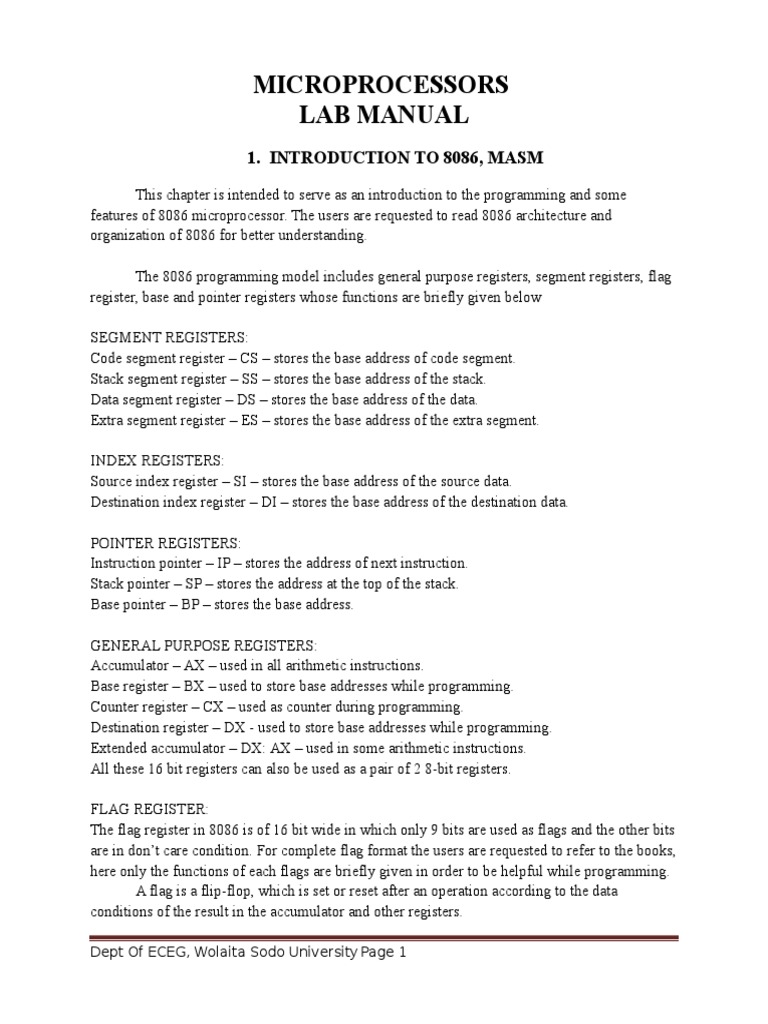
Programming in Assembler Laboratory manual. LAB PiA Ex.8. Project Igi 1 Unlimited Edition Game Torrent. MASM x64 –console application in Visual. To start programming it is necessary to follow few.
PDF Masm User Manual Pdf - bespbreakdonco. MASM, is a programming environment that You. 8086 Masm Lab Manual cs6412 syllabus,manual,anna university. IGNOU BCA Lab Manual Part-2,Assembly Language Programming.Uploaded. Lab Course Converting MASM 5.1 Object. Avtar Singh-The Lab Manual for 8088 and 8086.
Use CodeView to debug and execute an assembler language program Be able to use Codeview to view register contents, memory contents, and execution point. Be able to use Codeview to predict the behavior of the next instruction. Basic Information The three tools you will be working with are the Microsoft Macro Assembler (MASM), Codeview, and Programmer’s Work Bench. MASM is the assembler, which plays a role similar to a compiler in translating your text-based source code into the binary code of a computer. Translating assembly language source code into the equivalent binary machine code is a much simpler task than translating a program in a high level language. Therefore an assembler is a much simpler program than a compiler. The assembler translates source code on a statement by statement basis, with each source statement literally specifying an instruction.
One result of this is that the assembler can produce a “listing” file (.lst) that shows your assembly code side-by-side with the machine code generated. This list file can be a useful tool in understanding what is going on and can sometimes be used to aid in debugging. Codeview is the debugger provided with the Microsoft Assembly Language development system. It is a powerful debugger that allows you to run and single step your program. You may set break-points, view and modify memory, and view and modify registers as your program runs.
The Programmer’s Workbench is the development environment that ties everything together, much like any development environment such as Visual Studio, Borland or Watcom’s IDE (Integrated Development Environment), or the GNU tools on Linux. Unlike Visual Studio, PWB is a text based development environment running under MS-DOS. 2.1 Procedure The Microsoft MASM assembler programming package is actually a programming environment that contains four major features: the assembler and linker; complete online help with QuickHelp; Programmer’s WorkBench, and CodeView. The assembler and linker program is Microsoft version 6.1 that is called ML.EXE on the distribution disk. The assembler has all the features of earlier versions and is completely compatible with them. The ML.EXE program is normally accessed through Programmer’s WorkBench and not directly from the DOS command line.
The Programmer’s WorkBench or PWB is accessed from the DOS command line by typing PWB (or you may use the option in DOSSHELL). The PWB program coordinates the assembly language programming task by allowing access to the editor, online help, assembler, and CodeView for debugging. The MASM group is an integrated assembly language development package.
The CodeView feature displays the program in symbolic form and allows the program to be executed an instruction at a time, by groups of instructions, or completely. (you’ll understand what “symbolic form” means later when we contrast CodeView to the DOS utility DEBUG which doesn’t support symbolic debugging).
Debugging is accomplished by the display of the registers and sections of memory in various windows. Note that a mouse is not required for using the PWB package, but is highly recommended. 2.2 Using PWB Figure1 shows the startup screen in PWB. Across the top is the menu bar that contains 9 pulldown menus that access various features of PWB.